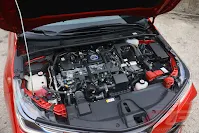In 2019, when Toyota Motor Philippines launched their first-ever mainstream gasoline-electric hybrid, the Corolla Altis, we took a look if taking the plunge towards electrified vehicles made economic sense. You can check out the full article here, but in gist, Corolla Altis Hybrid owners will only make up for the higher purchase price if they either drive more than 71,178 kilometers over a three-year period (23,726 kilometers per year), or if gas prices breach P 96.71 per liter.
That was then.
Today, as gas prices have doubled, we figured it’s time to re-examine those figures. Add to that Toyota Motor Philippines’ decision to add the Corolla Altis 1.6 V GR Sport this year—a new non-hybrid variant that further bridges the specs gap to the Corolla Altis 1.8 HEV—does going for a hybrid make monetary sense before the three-year warranty period expires?
What’s new in the Corolla Altis GR Sport?
Before crunching the numbers, let’s take a look first at what the Corolla Altis 1.6 V GR Sport has to offer. Priced at P 1,302,000, it replaces the Corolla Altis 1.6 V as the top-of-the-line non-hybrid variant in the local Corolla Altis range. It’s a P 87,000 jump to the now-discontinued 1.6 V and P 293,000 less than the 1.8 HEV.
By and large, it’s all about adding a sportier aesthetic to Toyota’s, admittedly, sedate-looking compact sedan. Changes include a new front grille and bumper filled with high-gloss black elements and a honeycomb insert. The same gloss black elements also find their way to the side mirrors (oddly enough, the door handles remain finished in chrome). It also gets a more aggressive side skirt, two-tone 17-inch alloy wheels, and a diffuser built into the rear bumper. A GR Sport badge on the trunk completes the exterior transformation.
Inside, the 2022 Corolla Altis 1.6 V GR Sport gets leather seats with red stitching (embossed with Gazoo Racing for good measure). The same red stitching makes its way onto the padded arm rest. The door handles also have red accents, while the push-button starter now has Gazoo Racing logo. Other amenities stay true to the 1.6 V on which it’s based on: power driver’s seat, automatic climate control with rear vents, rain-sensing wipers, power folding side mirrors, and more. Even the gauge opening animation hasn’t been changed here.
Speaking about performance, it shares the same 1.6-liter as the rest of the non-hybrid range—the 1ZR-FE makes 122 horsepower (same as the combined output of the gas-electric engine in the 1.8 HEV) and 153 Nm of torque. This engine’s mated exclusively paired with a CVT gearbox.
So, while the powertrain remains unchanged, Toyota did manage to add a suspension system tweaked by Gazoo Racing—a fact that has escaped most people, including us—and improved safety thanks to the standard Toyota Safety Sense.
The addition of Toyota Safety Sense has single-handedly closed the features gap to the 1.8 HEV. It bundles autonomous emergency braking, lane keep assist, adaptive cruise control. It also has rear parking sensors and camera (it’s worth noting that the revised 1.8 HEV also loses its front sensors). It also gets the full suite of SRS airbags, ABS with EBD, and stability control. Sadly, it still doesn’t have blind spot indicators—something already standard in its SUV derivative, the Corolla Cross (read our review).
Does the Corolla Altis GR Sport drive any different?
Having been able to sample the Corolla Altis 1.8 HEV and the Corolla Altis 1.6 V GR Sport for a week each, back-to-back, we’re going ahead and saying that, yes, there’s a difference.
Without a battery pack mounted underneath the back seat, the Corolla 1.6 V GR Sport feels a tad more responsive, especially when pushed. It still won’t be mistaken as a sporty compact, but at least it doesn’t feel as roly-poly. Together with the GR-tuned suspension, the body roll feels more controlled, and there’s also far less brake dive now even at moderate speeds. There’s also less “float.” Around the center, the steering still feels artificial and disconnected, but give it a good tug, and it does show some interest to what the driver’s doing, if only by a smidge.
Power-wise, the 1.6-liter is merely adequate. The initial throttle response is good, and couple that with commendable low-end torque makes the Corolla Altis 1.6 V GR Sport a great Point A to Point B commuter. That said, compared to the 1.8 HEV, it loses steam quite quickly. Without that electric motor boost, any moderate or high-speed overtake will require more coaxing from its engine. It doesn’t feel as constrained as, say, the HR-V S and its non-turbo 1.5-liter engine, but you can’t help but feel that the chassis could use a bit more grunt—the non-hybrid 1.8-liter would have been perfect.
The standard paddle shifters could have helped the Corolla Altis 1.6 V GR Sport’s case, but the weird part is that you can’t simply flick them at anytime to command a downshift. It requires you to slide the gear lever from D to M; only then can you work on the +/-.
So, what does the ownership costs look like?
Alright, some of you just want to know if going for the Corolla Altis 1.8 HEV makes economic sense given the high fuel prices, so enough with the driving impressions, and let’s work the numbers.
First, let’s lay down some assumptions:
The cost of Preventive Maintenance Service or PMS is based on actual service menu prices as of 2022. These are the prices quoted to us by an authorized Toyota dealership which we rang incognito, and covers the Corolla Altis’s (sadly) quarterly dealership visit.
The cost of Preventive Maintenance Service or PMS is based on actual service menu prices as of 2022. These are the prices quoted to us by an authorized Toyota dealership which we rang incognito, and covers the Corolla Altis’s (sadly) quarterly dealership visit.
We’ve also managed to confirm with the said dealer what Toyota Motor Philippines has been saying all along—the hybrid and non-hybrid have the same exact servicing requirement. The only exception is the traction battery filter cleaning/replacement which isn’t done in the first three years anyway.
Speaking of three years, we assumed a total traveling distance of 60,000 kilometers over a three-year period (20,000 kilometers per year). This may seem a lot, but at least it matches the prescribed PMS period covered by Toyota Motor Philippines during the three-year warranty period.
Lastly, for fuel mileage, these are the figures we’ve actually achieved when we had the Corolla Altis 1.8 HEV and the Corolla Altis 1.6 GR Sport for about a week each.
Let’s get to the numbers.
Thanks to the increase in gas prices, it’s now almost possible to breakeven when you opt for the Corolla Altis 1.8 HEV over the Corolla Altis 1.6 V GR Sport. Despite the close-to-P 300,000 price premium, the gas-electric hybrid will almost recoup itself as three-year investment (just a P 13,370.52 difference in favor of the Corolla Altis GR Sport) thanks to its more than double observed fuel economy—21.27 km/L versus 9.70 km/L.
If you want to be strict about it, the exact breakeven point between the Corolla Altis 1.8 HEV and the Corolla Altis 1.6 V GR Sport happens in one of two ways. First is that gas prices have to be higher than P 85.22—a real possibility given how things have been going lately, or if you travel more than 61,604.65 kilometers for three years (20,538.88 kilometers per year).
Conversely, if gas prices dip below P 78.13 per liter, you won’t be able to recoup the cost of the Corolla Altis 1.8 HEV. The same goes if you travel 56,481.35 over a three-year period (18,827.12 kilometers per year.)
We didn’t cover this in the chart below, but for those getting a Corolla Altis as part of a company car plan (in other words, your employer is paying the initial cost), going the Hybrid route keeps your running cost to just P 7.04 per kilometer—60 percent less than the Corolla Altis GR Sport. You also happen to save P 279,269.48 in fuel (assuming a P 83 per liter price tag).
So, there you have it. Thanks to sky-high fuel prices, going for a more fuel-efficient vehicle, even if it’s more expensive in the beginning, seems to be the right move in the longer term. It’s something we also see when we compare traditional gas- and diesel-fed vehicles versus hybrid and even electric vehicles.
Given the fuel prices, are you considering to get a hybrid, or perhaps even an EV?



































I don't think gas prices will go down like, pre-pandemic pricing. Even the if the Russo-Ukraine conflict comes to a halt, the problem also is that, here in our country, gas prices tend to shoot up really quickly BUT rollbacks are either rare OR provide piecemeal discounts. And THAT'S even before pandemic happened and the Russian invasion of Ukraine. Gas companies here not only use OPEC-dictated and world market pricing. The Oil Deregulation Law and excise taxes also played role in the expensive pricing which we have right now.
ReplyDeleteNeed to consider the lessened emissions and helping preserve mother earth to a degree or equivalent cost?
ReplyDeleteDears already lot of emissions produced by equopments in mining d minerals used in making d battery. Add to that, the environmental destruction caused by those mining on d prestine environment n also d emisions of coal producing d electricity used in charging EV's. So for now i think CE are more environment friendly than hybrids/EV's
ReplyDeletehard damage battery small lifetime. best gasoline lifetime.
ReplyDeletePrice of ownership should also include the possibility of parts breaking down. What’s the warranty condition of an HEV and parts availability. I’m sure many of you have seen on the internet the horrors of having EVs fixed especially if it’s on the battery side of things. There’s always that possibility that if it breaks down and service say the parts won’t be available for the next 3 months then what will you do? Heck it can even happen to regular cars what more on HEVs?
ReplyDelete